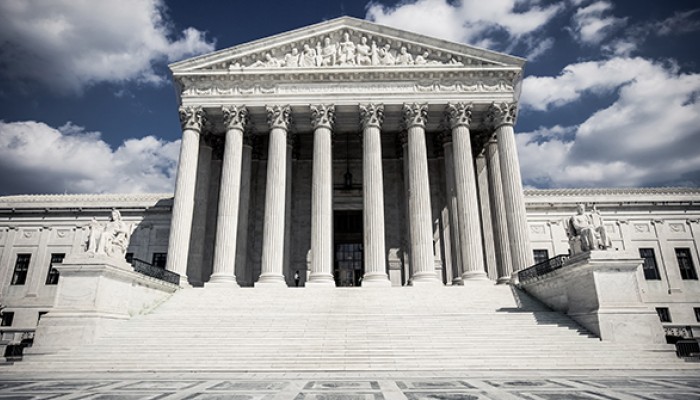On a sparkling Saturday morning earlier this month, Pete Buttigieg stood on an elevated back porch in Des Moines pitching his notions on changing the structure of the Supreme Court. As the 37-year-old mayor of South Bend, Indiana put it, “I’m trying to get everyone thinking about the fact that structural reforms are an option.”
Once Democrats limited themselves to talking about appointing Supreme Court justices who would uphold Roe v. Wade and overturn Citizens United. Now 2020 Democrats are openly discussing term limits for Supreme Court justices, increasing the number of justices on the court, and other reforms designed to thwart the conservative judicial vision.
At a mid-May town meeting in Nashua, New Hampshire, California Senator Kamala Harris said in response to a question, “I’m open to this conversation about increasing the number of people on the United States Supreme Court.” And Beto O’Rourke, the former three-term congressman who narrowly lost a Texas Senate race in 2018, has been pumping for his democracy agenda that includes a constitutional amendment mandating 18-year term limits for Supreme Court justices.
When the New York Times asked the 2020 Democrats about whether they favored expanding the size of the Supreme Court, Massachusetts Senator Elizabeth Warren said that she was “open” to the notion. Warren, a former Harvard law professor, pointed out, “The number of people on the Supreme Court is not constitutionally constricted.” Amy Klobuchar, who serves on the Senate Judiciary Committee, also said that she has an open mind on the question.
Call it the revenge of Merrick Garland, who never even received a Senate Judiciary Committee hearing when Barack Obama nominated him to fill Antonin Scalia’s seat in 2016.
Buttigieg, while speaking to about 150 voters in an affluent Des Moines neighborhood, made the Garland connection explicit. “Not only has the makeup and the size of the court changed about half a dozen times in American history,” he said, “but I would argue that it also changed in 2015 when the Republicans changed the number of justices on the Supreme Court temporarily to eight. And then they changed it back to nine when they took power.”
The South Bend mayor is correct that the number of Supreme Court justices, which can be altered by legislation, has varied from six to 10 at various points during the 18th and 19th centuries. But that number has been fixed at nine justices since 1869.
Rather than getting caught up in the merits of specific reform proposals, the real question is whether the Democrats, if victorious in 2020, should try to tinker with the structure of the court.
The obvious parallel is Franklin Roosevelt’s effort, shortly after his 46-state landslide reelection to a second term, to pack the Supreme Court.
Frustrated by a string of conservative Supreme Court decisions that endangered the future of the New Deal, FDR startled the political world in early 1937 by proposing a radical reshaping of the court. Under Roosevelt’s complicated legislative plan, the size of the court would increase each time a sitting justice reached his 70th birthday and failed to retire. What this meant in practice was that, if the legislation passed, Roosevelt would have the power to immediately appoint six new justices to augment the six who were then over 70.
FDR’s court-packing plan has been remembered as a case study in how even popular presidents can fall victim to the arrogance of power and over-extend their political mandates.
But the scheme, which was opposed by leading Senate New Dealers, also fell apart for other reasons. A conservative justice, Owen Roberts, suddenly decided that Roosevelt’s ambitious measures were constitutional after all and abandoned his reactionary allies. Another conservative jurist (Willis Van Devanter) retired opening up a seat for liberal Hugo Black. And, finally, Senate Majority Leader Joseph Robinson died suddenly depriving FDR of his most loyal ally in the court fight.
At a time when Donald Trump and Senate Majority Leader Mitch McConnell are shredding the norms of democracy on almost a daily basis, it is difficult to argue that Democrats should be constrained by Roosevelt’s failed legislative maneuver more than eight decades ago.
But the lasting moral from the court packing fight is that, in a functional democracy, structural problems often solve themselves. Even without legislation in the late 1930s, five Supreme Court justices either died or retired during Roosevelt’s second term allowing him to at last create a liberal majority.
The problem with 21st century efforts to reshape the Supreme Court is that, while legal, they seem like a banana-republic attempt to change the rules in the middle of the game. Yes, McConnell has trampled Senate traditions in the rush to confirm conservative judges. But if there is any hope to restore a less politicized judiciary after Trump leaves office, it will not be achieved by imitating McConnell’s bully tactics.
It is also plausible that elections could deprive McConnell of the ability to thwart Democrats’ attempts to fill vacancies on the courts. If, for example, a Democrat wins the presidency in 2020, it is not hard to imagine a 50–50 Senate with the Democratic vice-president casting the deciding vote. Also, the dwindling band of Senate GOP moderates like Alaska’s Lisa Murkowski (who is not up for reelection until 2022) may temper McConnell’s dreams of guaranteeing a permanent right-wing Supreme Court majority.
The principled argument against 21st-century court packing is that it is dangerous to tamper with the mechanisms of democracy to thwart a single political figure — in this case, McConnell. For times change while power eventually ebbs. But restructuring the Supreme Court could have lasting repercussions long after the current crisis is as forgotten as the mid-1930s conservative decisions that jeopardized the New Deal.
The views expressed are the author’s own and not necessarily those of the Brennan Center for Justice.
(Image: P_Wei)

